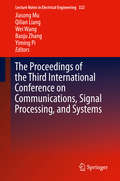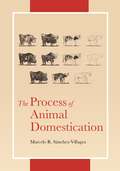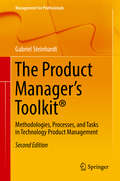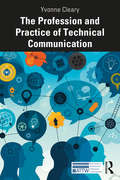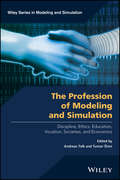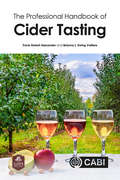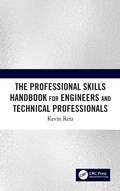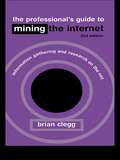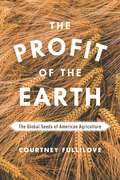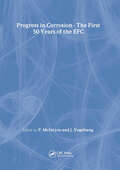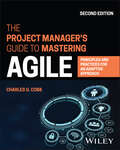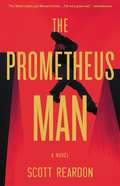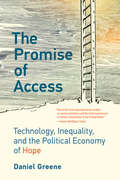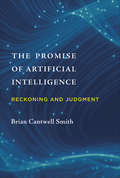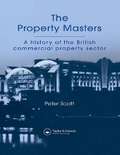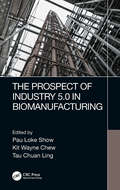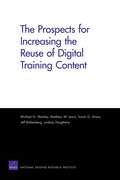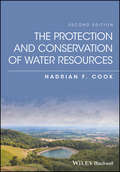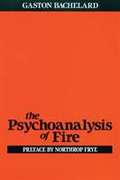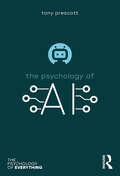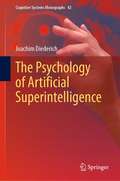- Table View
- List View
The Proceedings of the Third International Conference on Communications, Signal Processing, and Systems
by Qilian Liang Yiming Pi Wei Wang Jiasong Mu Baoju ZhangThe Proceedings of The Third International Conference on Communications, Signal Processing and Systems provides the state-of-art developments of Communications, Signal Processing and Systems. The conference covered such topics as wireless communications, networks, systems, signal processing for communications. This book is a collection of contributions coming out of Third International Conference on Communications, Signal Processing and Systems held on July 2014 in Hohhot, Inner Mongolia, China.
The Process of Animal Domestication
by Marcelo Sánchez-VillagraThe first modern scholarly synthesis of animal domesticationAcross the globe and at different times in the past millennia, the evolutionary history of domesticated animals has been greatly affected by the myriad, complex, and diverse interactions humans have had with the animals closest to them. The Process of Animal Domestication presents a broad synthesis of this subject, from the rich biology behind the initial stages of domestication to how the creation of breeds reflects cultural and societal transformations that have impacted the biosphere.Marcelo Sánchez-Villagra draws from a wide range of fields, including evolutionary biology, zooarchaeology, ethnology, genetics, developmental biology, and evolutionary morphology to provide a fresh perspective to this classic topic. Relying on various conceptual and technical tools, he examines the natural history of phenotypes and their developmental origins. He presents case studies involving mammals, birds, fish, and insect species, and he highlights the importance of domestication for the comprehension of evolution, anatomy, ontogeny, and dozens of fundamental biological processes.Bringing together the most current developments, The Process of Animal Domestication will interest a wide range of readers, from evolutionary biologists, developmental biologists, and geneticists to anthropologists and archaeologists.
The Procurement and Management of Small Works and Minor Maintenance: The Principal Considerations for Client Organisations (Chartered Institute of Building)
by Alan Griffith Jeremy HeadleyMany client organisations occupy large and often diverse property estates which require significant expenditure on maintenance, alterations, refurbishment or small-scale new building work. Effective organisation and efficient allocation of resources are essential to ensure that the works are carried out successfully.This book provides a detailed introduction to small works procurement and management within the large client organisation, a significant sector of the construction industry which has hitherto been neglected by researchers. In the large organisational context, characterised by large property holdings perhaps over wide geographic areas, the importance of ensuring maximum efficiency of resource use is crucial. If the regular and numerous work which is required throughout the year is not carried out in line with organisational goals then the core business will suffer.The book focuses on the suitability, efficiency and effectiveness of procurement, organisation and management of small works, and outlines the main stages in the formulation and implementation of well-defined and measurable objectives. Overall it will enable the reader to understand the decision factors involved in designing a small works procurement strategy.The Procurement and Management of Small Works and Minor Maintenance is an indispensible reference for all facilities managers, consultants and contractors. It is also useful reading for undergarduate and postgraduate courses in building, construction management, maintenance and facilities management.
The Product Manager's Toolkit®
by Gabriel SteinhardtProduct management is challenging, complex, and often misunderstood. Across the high-tech industry, drastically different duties and responsibilities are attributed to product management professionals. Diverse interpretations regarding the role of product management have only further confused practitioners and stifled the ability to develop clear and consistent product management methodologies. "The Product Manager's Toolkit" book provides a consistent and holistic managerial approach to product management and presents a practical and comprehensive methodology (tasks, processes, deliverables, and roles) that covers nearly all aspects of product management.
The Profession and Practice of Horticultural Therapy
by Rebecca L. Haller Christine L. Capra Karen L. KennedyThe Profession and Practice of Horticultural Therapy is a comprehensive guide to the theories that horticultural therapists use as a foundation for their practice and provides wide-ranging illustrative models of programming. This book aims to enhance understanding and provide insight into the profession for both new and experienced practitioners. It is directed to students in the field, along with health care and human service professionals, to successfully develop and manage horticultural therapy programming. The book is organized into four sections: an overview of the horticultural therapy profession, theories supporting horticultural therapy use, models for programs, and tools for the therapist. Areas of focus include: Overview of the profession, including the knowledge, skills, and abilities needed to practice Discussion of related people-plant endeavors and theories supporting horticultural therapy Issues within the profession of horticultural therapy, including employment models, professionalism and ethics, and credentials Characteristics and implementation of therapeutic, vocational, and wellness program models Accommodations and adaptive techniques to best serve the needs of all participants Strategies for assessment and documentation for horticultural therapy intervention Issues for managing programs including how horticultural therapy programs collaborate with other disciplines, determining program costs and budget, managing staff and growing spaces, and conducting program evaluations Horticultural therapy serves the needs of the whole individual when practitioners have a broad and deep comprehension of the theories, techniques, and strategies for effective program development and management. The Profession and Practice of Horticultural Therapy provides relevant and current information on the field with the intent to inspire best practices and creative, effective programs.
The Profession and Practice of Technical Communication (ATTW Series in Technical and Professional Communication)
by Yvonne ClearyThis practical text offers a research-based account of the technical communication profession and its practice, outlining emergent touchpoints of this fast-changing field while highlighting its diversity. Through research on the history and the globalization of technical communication and up-to-date industry analysis, including first-hand narratives from industry practitioners, this book brings together common threads through the industry, suggests future trends, and points toward strategic routes for development. Vignettes from the workplace and examples of industry practice provide tangible insights into the different paths and realities of the field, furnishing readers with a range of entry routes and potential career sectors, workplace communities, daily activities, and futures. This approach is central to helping readers understand the diverse competencies of technical communicators in the modern, globalized economy. The Profession and Practice of Technical Communication provides essential guidance for students, early professionals, and lateral entrants to the profession and can be used as a textbook for technical communication courses.
The Profession of Modeling and Simulation
by Andreas Tolk Tuncer ÖrenThe definite guide to the theory, knowledge, technical expertise, and ethical considerations that define the M&S profession From traffic control to disaster management, supply chain analysis to military logistics, healthcare management to new drug discovery, modeling and simulation (M&S) has become an essential tool for solving countless real-world problems. M&S professionals are now indispensable to how things get done across virtually every aspect of modern life. This makes it all the more surprising that, until now, no effort has been made to systematically codify the core theory, knowledge, and technical expertise needed to succeed as an M&S professional. This book brings together contributions from experts at the leading edge of the modeling and simulation profession, worldwide, who share their priceless insights into issues which are fundamental to professional success and career development in this critically important field. Running as a common thread throughout the book is an emphasis on several key aspects of the profession, including the essential body of knowledge underlying the M&S profession; the technical discipline of M&S; the ethical standards that should guide professional conduct; and the economic and commercial challenges today’s M&S professionals face. • Demonstrates applications of M&S tools and techniques in a variety of fields—such as engineering, operations research, and cyber environments—with over 500 types of simulations • Highlights professional and academic aspects of the field, including preferred programming languages, professional academic and certification programs, and key international societies • Shows why M&S professionals must be fully versed in the theory, concepts, and tools needed to address the challenges of cyber environments The Profession of Modeling and Simulation is a valuable resource for M&S practitioners, developers, and researchers working in industry and government. Simulation professionals, including administrators, managers, technologists, faculty members, and scholars within the physical sciences, life sciences, and engineering fields will find it highly useful, as will students planning to pursue a career in the M&S profession. “ …nearly three dozen experts in Modeling and Simulation (M&S) come together to make a compelling case for the recognition of M&S as a profession… Important reading for anyone seeking to elevate the standing of this vital field.” Alfred (Al) Grasso, President & CEO, The MITRE Corporation Andreas Tolk, PhD, is Technology Integrator for the Modeling, Simulation, Experimentation, and Analytics Division of The MITRE Corporation, an adjunct professor in the Department of Engineering Management and Systems Engineering and the Department for Modeling, Simulation, and Visualization Engineering at Old Dominion University, and an SCS fellow. Tuncer Ören, PhD, is Professor Emeritus of Computer Science at the University of Ottawa. He is an SCS fellow and an inductee to SCS Modeling and Simulation Hall of Fame. His research interests include advancing methodologies, ethics, body of knowledge, and terminology of modeling and simulation.
The Professional Handbook of Cider Tasting
by Dr Travis Robert Alexander Dr Brianna Ewing ValliereIn recent years, with the rise of the craft beverage movement, the cider industry has been through a period of rapid commercial and non-commercial growth. Tasting and quality control is a core aspect of successful cider making and it is essential for industry and researchers to characterize cider using a standard, quantifiable metric. This book is a research-based text for understanding both the theory and practice of effectively evaluating the sensory properties of cider. The Professional Handbook of Cider Tasting includes content on the physiological basis of sensory evaluation, effective profiling of sensory evaluation, types and styles of cider, origins of cider quality attributes and direction for pairing cider with foods. The book also: - Covers a broad range of cider tasting techniques with associated technical explanations. - Provides data and research-driven information. - Contains sample sensory evaluation sheets, a tasting wheel, and guidance for creating fresh cider sensory standards and the utilization of various apple cultivars. Including a summary of the current global cider styles, this is an invaluable resource for commercial cidermakers, non-commercial cidermakers, students on cider production courses, researchers and other industry and stakeholder personnel.
The Professional Skills Handbook For Engineers And Technical Professionals
by Kevin RetzThis new handbook covers a wide range of engineering skills generally not taught in today's college-level technical programs. New engineers, though technically sound, need to master these other skills upon entering the professional world. Topics covered include teaming, root cause analysis, Lean manufacturing and management, presentation skills, innovation, and change leadership. Based on the author’s 30 years of engineering and leadership experience, this work contains a wealth of practical tips and advice, as well as lessons learned the hard way. Portable and concise, the handbook can help new engineers thrive in and enjoy the technical world and their professional careers.
The Professional's Guide to Mining the Internet: Infromation Gathering and Research on the Net
by Clegg, BrianWhatever is needed, from in-depth research material for a report or academic paper, to the telephone number of a company on the other side of the world or what is showing at the local cinema, this guide aims to help readers find the answer on the internet, faster and more easily.
The Profit of the Earth: The Global Seeds of American Agriculture
by Courtney FulliloveWhile there is enormous public interest in biodiversity, food sourcing, and sustainable agriculture, romantic attachments to heirloom seeds and family farms have provoked misleading fantasies of an unrecoverable agrarian past. The reality, as Courtney Fullilove shows, is that seeds are inherently political objects transformed by the ways they are gathered, preserved, distributed, regenerated, and improved. In The Profit of the Earth, Fullilove unearths the history of American agricultural development and of seeds as tools and talismans put in its service. Organized into three thematic parts, The Profit of the Earth is a narrative history of the collection, circulation, and preservation of seeds. Fullilove begins with the political economy of agricultural improvement, recovering the efforts of the US Patent Office and the nascent US Department of Agriculture to import seeds and cuttings for free distribution to American farmers. She then turns to immigrant agricultural knowledge, exploring how public and private institutions attempting to boost midwestern wheat yields drew on the resources of willing and unwilling settlers. Last, she explores the impact of these cereal monocultures on biocultural diversity, chronicling a fin-de-siècle Ohio pharmacist’s attempt to source Purple Coneflower from the diminishing prairie. Through these captivating narratives of improvisation, appropriation, and loss, Fullilove explores contradictions between ideologies of property rights and common use that persist in national and international development—ultimately challenging readers to rethink fantasies of global agriculture’s past and future.
The Progress in Corrosion - The First 50 Years of the EFC (European Federation of Corrosion Publications)
by Paul McIntyreThis book focuses on developments during the first fifty years of existence of the European Federation of Corrosion, and describes the contributions made by its working parties.
The Project Manager's Guide to Mastering Agile: Principles and Practices for an Adaptive Approach
by Charles G. CobbTHE PROJECT MANAGER’S GUIDE TO MASTERING AGILE Updated guide to Agile methodologies, with real-world case studies and valuable frameworks for project managers moving to Agile The Project Manager’s Guide to Mastering Agile helps project managers who are faced with the challenge of adapting their project management approach to an Agile environment, showing how these approaches can work jointly to improve project outcomes in any project, with discussion topics and real-world case studies that facilitate hands-on learning. It also provides project managers with the fundamental knowledge to take a leadership role in working with companies to develop a well-integrated, enterprise-level Agile Project Management approach to fit their business. The original edition of this book has been very successful and is used as a graduate-level textbook in several universities. This new edition builds on the success of the original edition and includes updated content from the latest PMBOK Guide, updated sections on stakeholder management, value-driven delivery, adaptive planning, and distributed project management, with an all-new chapter on Hybrid project management. It also includes new case studies on applying an Agile Hardware Development at Tesla and Project Management in a non-software environment. Sample topics covered in The Project Manager’s Guide to Mastering Agile include: Bridging the chasm in project management philosophies, impact on the project management profession, evolution of Agile and Waterfall, and learning to see Agile and traditional plan-driven project management as complementary to each other rather than competitive The roots of Agile and understanding Agile at a deeper level including the Agile manifesto from 2001, adapting an Agile approach to fit a business, and Scrum overview, roles, framework, principles, and values Time-boxing, Kanban, and theory of constraints, Agile estimation overview and estimation practices, and velocity and burn-down/burn-up charts Scaling Agile to an enterprise level, including challenges, obstacles to overcome, implementation considerations, management practices, and enterprise-level Agile transformations With comprehensive, accessible, and highly practical coverage of Agile, a leading project management platform, The Project Manager’s Guide to Mastering Agile is a highly valuable resource for professional project managers, students studying project management, and those studying for PMI’s Agile Certified Practitioner Certification (PMI-ACP).
The Prometheus Man
by Scott ReardonA man with no identity... hunting a man without limits. When a pile of bodies is found in Paris, CIA Agent Tom Blake hustles his way onto a major case: tracking a man with enhanced abilities, the test subject of a secret government program. There's just one problem: the man using Agent Blake's identity is not Agent Blake. He's Tom Reese, a man without a family or a home. Reese is searching for his brother's killer. He stole Agent Blake's identity two months ago and has bluffed his way onto the team investigating his only lead. But his time as a CIA agent is accelerating toward its expiration date.Soon the CIA will find out that Agent Blake is in two places at once. Soon the augmented man will come looking for him. And soon both will discover that Tom Reese carries a secret even he doesn't know about. He is the last test subject of Project Prometheus.
The Promise of Access: Technology, Inequality, and the Political Economy of Hope
by Daniel GreeneWhy simple technological solutions to complex social issues continue to appeal to politicians and professionals who should (and often do) know better.Why do we keep trying to solve poverty with technology? What makes us feel that we need to learn to code--or else? In The Promise of Access, Daniel Greene argues that the problem of poverty became a problem of technology in order to manage the contradictions of a changing economy. Greene shows how the digital divide emerged as a policy problem and why simple technological solutions to complex social issues continue to appeal to politicians and professionals who should (and often do) know better.
The Promise of Artificial Intelligence: Reckoning and Judgment
by Brian Cantwell SmithAn argument that—despite dramatic advances in the field—artificial intelligence is nowhere near developing systems that are genuinely intelligent.In this provocative book, Brian Cantwell Smith argues that artificial intelligence is nowhere near developing systems that are genuinely intelligent. Second wave AI, machine learning, even visions of third-wave AI: none will lead to human-level intelligence and judgment, which have been honed over millennia. Recent advances in AI may be of epochal significance, but human intelligence is of a different order than even the most powerful calculative ability enabled by new computational capacities. Smith calls this AI ability “reckoning,” and argues that it does not lead to full human judgment—dispassionate, deliberative thought grounded in ethical commitment and responsible action.Taking judgment as the ultimate goal of intelligence, Smith examines the history of AI from its first-wave origins (“good old-fashioned AI,” or GOFAI) to such celebrated second-wave approaches as machine learning, paying particular attention to recent advances that have led to excitement, anxiety, and debate. He considers each AI technology's underlying assumptions, the conceptions of intelligence targeted at each stage, and the successes achieved so far. Smith unpacks the notion of intelligence itself—what sort humans have, and what sort AI aims at. Smith worries that, impressed by AI's reckoning prowess, we will shift our expectations of human intelligence. What we should do, he argues, is learn to use AI for the reckoning tasks at which it excels while we strengthen our commitment to judgment, ethics, and the world.
The Property Masters: A history of the British commercial property sector
by P. ScottThis is a thorough exploration of the evolution of the commercial property investment and development markets from the mid-nineteenth century to the present day. It explains how the current investment scene emerged and fills an important gap in the literature on the property market.
The Prospect of Industry 5.0 in Biomanufacturing
by Pau Loke ShowThis is the first book to present the idea of Industry 5.0 in biomanufacturing and bioprocess engineering, both upstream and downstream. The Prospect of Industry 5.0 in Biomanufacturing details the latest technologies and how they can be used efficiently and explains process analysis from an engineering point of view. In addition, it covers applications and challenges. FEATURES Describes the previous Industrial Revolution, current Industry 4.0, and how new technologies will transition toward Industry 5.0 Explains how Industry 5.0 can be applied in biomanufacturing Demonstrates new technologies catered to Industry 5.0 Uses worked examples related to biological systems This book enables readers in industry and academia working in the biomanufacturing engineering sector to understand current trends and future directions in this field.
The Prospects for Increasing the Reuse of Digital Training Content
by Lindsay Daugherty Matthew W. Lewis Jeff Rothenberg Michael G. Shanley Susan G. StrausThis study examined how the Advanced Distributed Learning (ADL) Initiative might encourage the reuse of digital training content as a strategy to reduce the cost of its development. While findings highlighted a number of current challenges with the reuse option, one conclusion is that ADL can foster more reuse by taking a proactive approach in supporting training development organizations that are attempting to implement a reuse strategy.
The Protection and Conservation of Water Resources
by Hadrian F. CookThis book is about water - in Britain, and in the world. It is about water resources, their conservation, protection of water quality for human consumption and aquatic ecosystems. Since the publication of the first edition in 1998, major political and regulatory changes have taken place; this book provides a clear and comprehensive update of conservation and water resource management issues in the UK over the past two decades, and – in an expansion of its original UK perspective – now includes examples of global best practice. The UK’s 2003 adoption of the EU Water Framework Directive has had enormous implications for the conservation and management of our water resources. In 2016, with the UK’s decision to leave the EU, the governance scene is entering upon an unpredictable future regarding its major water resource policies. The Protection and Conservation of Water Resources, Second edition provides a clear and comprehensive update of conservation and water resource management issues. Chapter 1 deals with sustainability and water policy, outlines the issues and challenges, and asks: what is integrated water management? Chapter 2 reviews water availability and sufficiency in Britain, while Chapter 3 explores the dynamic between institutions and legislative framework. Chapter 4 introduces the catchment approach, and chapters 5 and 6 explore the issues of sustaining bulk supply and the imperatives of climate change. Chapter 7 looks at the contemporary background to water quality issues, and Chapter 8 provides case studies of catchment problems, both urban and rural. Chapter 9 describes solutions in land use change, including technical fixes and their sustainability. Chapter 10 is concerned with emerging governance arrangements, and Chapter 11 takes a global view, looking at successful examples around the world to find positive lessons from Europe, north America and Australia.
The Proving Ground: The Inside Story of the 1998 Sydney to Hobart Race
by G. Bruce KnechtThe story of one of the worst disasters in modern yachting history. 115 boats that started under clear skies in Sydney, just 43 would finish...after the fleet had been ripped apart by unforecast winds and 80-foot-high waves.
The Prunus mume Genome (Compendium of Plant Genomes)
by Zhihong GaoThis book reviews the current status of P. mume research, highlighting how the new data coming from the release of the P. mume genomes can advance science and help to solve a number of problems facing the P. mume industry. Prunus mume, which was domesticated in China more than 3,000 years ago as an ornamental plant and for its fruit, is one of the first genomes among the Prunus subfamilies of the Rosaceae family that has been sequenced. Combining the P. mume genome with available data, scientists have succeeded in reconstructing nine ancestral chromosomes of the Rosaceae family, as well as the chromosome fusion, fission and duplication history of three major subfamilies. The P. mume genome sequence adds to our understanding of Rosaceae evolution and provides an important basis for the improvement of fruit trees. This book offers an essential a guide for all those who are interested in gene discovery, comparative genomics, molecular breeding and new breeding techniques; and will be particularly useful for scientists, breeders, university students, and public sector institutes that are involved in the P. mume industry and/or Rosaceae research.
The Psychoanalysis of Fire
by Gaston Bachelard; Alan C. M. RossTo define him as briefly as possible - he is a philosopher, with a professional training in the sciences, who devoted most of the second phase of his career to promoting that aspect of human nature which often seems most inimical to science: the poetic imagination.
The Psychology of Artificial Intelligence (The Psychology of Everything)
by Tony PrescottWhat is Artificial Intelligence? How will AI impact society? Is AI more powerful than human intelligence?The Psychology of AI explores all aspects of the psychology–AI relationship, asking how closely AI can resemble humans, and whether this means they could have some form of self-awareness. It considers how AI systems have been modelled on human intelligence and the similarities between brains and computers, along with the current limitations of AI and how these could be overcome in the future. It also looks at how people interact with AI in their everyday lives, exploring some of the ethical and societal risks, such as bias in AI algorithms, and the consequences for our long-term future if AIs do surpass humans in important ways.As AI continues to break new milestones, The Psychology of AI answers key questions about what it really means to be human, and how AI will impact our lives in every way, now and into the future.
The Psychology of Artificial Superintelligence (Cognitive Systems Monographs #42)
by Joachim DiederichThis book explores the psychological impact of advanced forms of artificial intelligence. How will it be to live with a superior intelligence? How will the exposure to highly developed artificial intelligence (AI) systems change human well-being? With a review of recent advancements in brain–computer interfaces, military AI, Explainable AI (XAI) and digital clones as a foundation, the experience of living with a hyperintelligence is discussed from the viewpoint of a clinical psychologist. The theory of universal solicitation is introduced, i.e. the demand character of a technology that wants to be used in all aspects of life. With a focus on human experience, and to a lesser extent on technology, the book is written for a general readership with an interest in psychology, technology and the future of our human condition. With its unique focus on psychological topics, the book offers contributions to a discussion on the future of human life beyond purely technological considerations.
